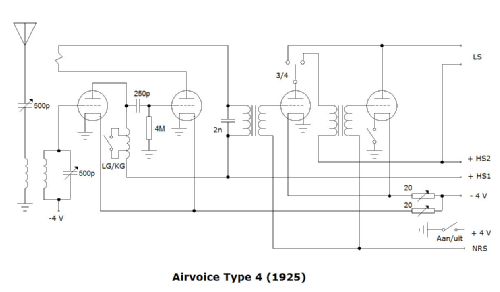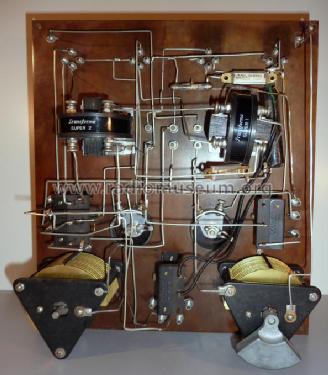- Pays
- Pays-Bas
- Fabricant / Marque
- Airvoice Radio, N. V., Amsterdam
- Année
- 1925
- Catégorie
- Radio - ou tuner d'après la guerre 1939-45
- Radiomuseum.org ID
- 196093
Cliquez sur la vignette du schéma pour le demander en tant que document gratuit.
- No. de tubes
- 4
- Principe général
- Récepteur TRF en général (avec ou sans réaction inconnu)
- Circuits accordés
- 2 Circuits MA (AM)
- Gammes d'ondes
- PO et GO
- Tension / type courant
- Piles (rechargeables ou/et sèches) / 4 & 45 & 90 Volt
- Haut-parleur
- - Ce modèle nécessite des HP externes
- Matière
- Boitier en bois, lampes visibles
- De Radiomuseum.org
- Modèle: Type 4 - Airvoice Radio, N. V.,
- Forme
- Modèle de table à panneau incliné
- Dimensions (LHP)
- 340 x 325 x 315 mm / 13.4 x 12.8 x 12.4 inch
- Remarques
- Ebonite sloping control panel and oak cabinet. Classic lectern shaped model. The control panel was originally made of shining flamed black and brown ebonite. Exposure to sunlight gave the front plate an even brown colour. The highly symmetrical control panel is divided into four rows. In the first row, obscured by the four valves, binding posts for antenna and earth, situated on the upper left and right. In the second row we can see three coil holders. In the third row holds two rheostats. Left of the rheostats a switch that can be used to operate the radio on 3 or 4 valves; the on/off switch is situated on the right of the rheostats. The sockets on the left are for grid bias and filament voltage and the sockets on the left are for the plate voltages. Below the two switches, we see the knobs for primary and secondary tuning, the wave length switch and sockets for headphones and/or loudspeaker. It is a secondary receiver with inductive coupling. A remarkable detail in this circuit is the fact that reaction takes place over two stages, a custom dating back to the time of bright emitters. Because of that, the right coil behaves in a different way: because of the extra phase shift, the point of maximum reaction lays further away from the central coil. The original valve set is not known. Looking at the circuit, both LF tubes must have been the same. The Airvoice Type 7 resembles the Airvoice Type 4 receiver, but that radio has internal coils.
- Source
- - - Data from my own collection
- Auteur
- Modèle crée par John Koster. Voir les propositions de modification pour les contributeurs supplémentaires.
- D'autres Modèles
-
Vous pourrez trouver sous ce lien 4 modèles d'appareils, 4 avec des images et 1 avec des schémas.
Tous les appareils de Airvoice Radio, N. V., Amsterdam


